SPECIAL
From ceramics to porcelain
You will probably know that making clay objects is one of the most ancient human activities.
As far back as Neolithic times, man began to mould simple dishes out of clay to decorate them with fingerprints, shells and the like. Later, the pottery was fired to become harder and more resistant.
It has been nearly 7,000 years since people first began to grow wheat, peas, beans and lentils. All the while they sought the ways of preserving the foods. And so they started making jars of clay.
It was all very rudimentary at first. The most important thing was choosing the right kind of clay, the one sticky enough. The ancient potters would treat clay by removing all impurities and form it like cylinders. The actual production began as the cylindrical shape was changed into a spiral (water was being added) and then a bowl. The bowl would be left to dry and harden to prevent damage. After on hour, the rim of the bowl would be wetted and formed by attaching hoops.
When such a jar, typically used for wheat, would dry, the ancient potters would leave it on fire for at least two hours. When the fire consumed all the wood, the clay product would be finished. Not all dishes passed the fire exam as some cracked and other were wrecked by wood fragments.
The invention of the potter’s wheel, probably by old Semitic peoples such as the Hittites, sped up the production of round dishes.
The basic skills of brick-glazing can be read from the findings at the archaeological sites of Babylon and Mesopotamia. Also, outstanding ceramic dishes were found in the tombs of Egyptian pharaohs. In ancient Greece, there were the amphorae and vases with well-known black-red motifs. And after the great migration of the peoples, the Moors introduced their ceramics to Spain.
What about China?
In the Far East, as in China, porcelain began to be made as early as the 7th century AD, the process was kept secret and exclusive exports to Europe began from the 13th century.
How porcelain came to Europe
Did you know how porcelain reached Europe?
Chinese first mastered the skill of firing porcelain. In the 7th century BC, the so-called proto-porcelain began to be made in China. The products were neither entirely white nor translucent.
Genuine porcelain has been produced in China since then. The term kaolin (one of the basic ingredients of porcelain) comes from the name of the mountain Gao-Ling, where the porcelain clay was being dug.
Celadon, the porcelain with a pale grey-green glaze, was made exclusively for the emperor and his court.
Returning from Asia, Marco Polo brought china to Europe before the year 1290. The term porcelain originates from porcella, or a seashell in Italian, as the material resembled seashells both in bulk and when fragmented.
Porcelain in Europe
Ever since, Europe has striven to make porcelain seeking to uncover the closely guarded secret of china-making from the Chinese.
In the 15th century, porcelain began to be imported from China in larger quantities but was still rather expensive, considering its counter value in gold.
In this period, china symbolised prestige for European aristocracy, appealing to the nobility with its rich colour and delicate ornamentation.
Until then, Europe had been unable to create as high temperatures as were necessary for the firing (and making) of porcelain.
Among the initial European attempts was the so-called Medici porcelain, in the 15th century Italy. White but hardly as translucent as Chinese porcelain, its decoration imitated Chinese motifs in cobalt.
Similarly, the famous Fanases Delft, Holland, copied the Chinese patterns.
Meanwhile, Chinese ships loaded with fine, fragile goods unloaded at the ports of Amsterdam, Genoa and Venice and from there the china went to royal courts and glamorous palaces. The era’s richest people competed with precious collections as symbols of prestige and power.
Discovering the secret of china-making
It was Ehrenfried Walther von Tschirnhaus and doctor Johann Friedrich Böttger that finally discovered the secret of porcelain material in Meissen in 1708.
Their first attempts at porcelain resembled hard reddish-brown stone. Kaolin came in only after baroque wigs began to be powdered.
A secret is also kept at Meissen
Soon afterwards a pottery for this semi-porcelain was opened in Meissen in 1708. Both gentlemen worked hard to break the code of the compound.
Finally, Böttger succeeded in 1709, only a year after Von Tschirnhaus had died.
Next year, the first porcelain pottery was established in Meissen and run by Böttger until his death in 1719. In 1718, a few workers of the Meissen castle leaked out the porcelain-making know-how. Another porcelain pottery was set up in Vienna in 1718.
How is porcelain made?
First off, the material is prepared. It is:
- 50 percent kaolin (white, watered, greasy and plastic earthen substance created by complex changes in feldspar) and
- 50 percent non-plastic substances (half feldspar paste for easier melting and half quartz for texture).
In 1718, Dutchman Claudis Innocetius du Paquler opened the second European porcelain pottery in Vienna and from the mid-18th century, factories were being started all over Europe.
To make porcelain, we need:
- kaolin,
- feldspar paste,
- quartz and other ingredients.
The various mutual ratios of these substances define hard and soft porcelain.
Hard porcelain is made of 40-65 % kaolin like most of the European factories, soft eastern-Asian porcelain contains under 40% kaolin and the remaining substances, the feldspar paste and quartz, in a 50-50 proportion, account for the rest. Dental porcelain is over 80% feldspar. The compound is kneaded and rubbed, washed and then shaped.
After the material shaped to preference and then, importantly, dried and fired in a tunnel kiln at over 900°C. This porcelain called biscuit may or may not be glazed. If glazed, it needs another heat treatment, at 1450°C, afterwards. This done, the process is nearly complete with the exception of decoration which we will see later.
What is kaolin?
Kaolin is a pure substance originating from feldspar, maximally hard, transparent and white and fired at over 1300°C. It has to be fired in a limited space, that is, with as little air as possible, to secure its whiteness and prevent the unwanted change of colouration by iron impurities.
Porcelain density is about 1231 kg/m2 Kaolin was named after the mountain Gao–Lin in China where this substance was first found.
|



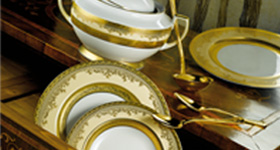
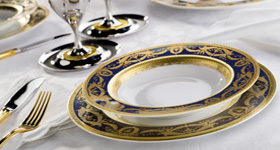

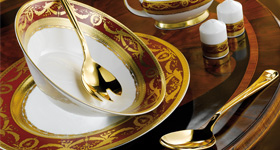
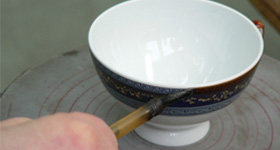

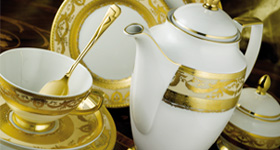 |